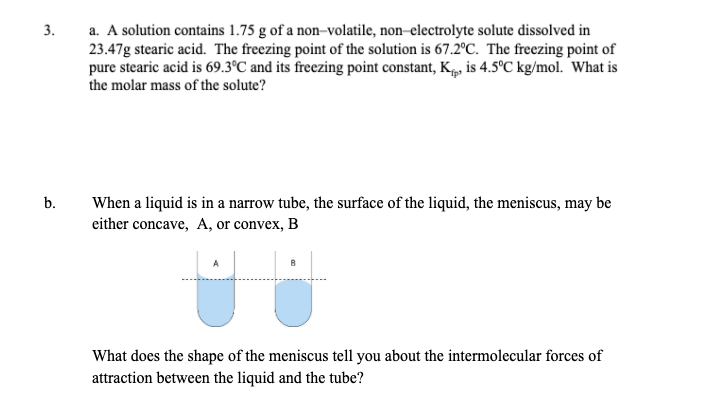3. a. A solution contains 1.75 g of a non-volatile, non-clectrolyte solute dissolved in 23.47g stearic acid. The freezing point of the solution is 67.2°C. The freezing point of pure stearic acid is 69.3°C and its freezing point constant, Kp, is 4.5°C kg/mol. What is the molar mass of the solute? b. When a liquid is in a narrow tube, the surface of the liquid, the meniscus, may be either concave, A, or convex, B What does the shape of the meniscus tell you about the intermolecular forces of attraction between the liquid and the tube?
3. a. A solution contains 1.75 g of a non-volatile, non-clectrolyte solute dissolved in 23.47g stearic acid. The freezing point of the solution is 67.2°C. The freezing point of pure stearic acid is 69.3°C and its freezing point constant, Kp, is 4.5°C kg/mol. What is the molar mass of the solute? b. When a liquid is in a narrow tube, the surface of the liquid, the meniscus, may be either concave, A, or convex, B What does the shape of the meniscus tell you about the intermolecular forces of attraction between the liquid and the tube?
Chemistry: An Atoms First Approach
2nd Edition
ISBN:9781305079243
Author:Steven S. Zumdahl, Susan A. Zumdahl
Publisher:Steven S. Zumdahl, Susan A. Zumdahl
Chapter10: Properties Of Solutions
Section: Chapter Questions
Problem 5ALQ: You have read that adding a solute to a solvent can both increase the boiling point and decrease the...
Related questions
Question

Transcribed Image Text:3.
a. A solution contains 1.75 g of a non-volatile, non-clectrolyte solute dissolved in
23.47g stearic acid. The freezing point of the solution is 67.2°C. The freezing point of
pure stearic acid is 69.3°C and its freezing point constant, Kp, is 4.5°C kg/mol. What is
the molar mass of the solute?
b.
When a liquid is in a narrow tube, the surface of the liquid, the meniscus, may be
either concave, A, or convex, B
What does the shape of the meniscus tell you about the intermolecular forces of
attraction between the liquid and the tube?
Expert Solution
This question has been solved!
Explore an expertly crafted, step-by-step solution for a thorough understanding of key concepts.
Step by step
Solved in 2 steps with 1 images

Knowledge Booster
Learn more about
Need a deep-dive on the concept behind this application? Look no further. Learn more about this topic, chemistry and related others by exploring similar questions and additional content below.Recommended textbooks for you

Chemistry: An Atoms First Approach
Chemistry
ISBN:
9781305079243
Author:
Steven S. Zumdahl, Susan A. Zumdahl
Publisher:
Cengage Learning


Chemistry
Chemistry
ISBN:
9781305957404
Author:
Steven S. Zumdahl, Susan A. Zumdahl, Donald J. DeCoste
Publisher:
Cengage Learning

Chemistry: An Atoms First Approach
Chemistry
ISBN:
9781305079243
Author:
Steven S. Zumdahl, Susan A. Zumdahl
Publisher:
Cengage Learning


Chemistry
Chemistry
ISBN:
9781305957404
Author:
Steven S. Zumdahl, Susan A. Zumdahl, Donald J. DeCoste
Publisher:
Cengage Learning

Chemistry: Principles and Reactions
Chemistry
ISBN:
9781305079373
Author:
William L. Masterton, Cecile N. Hurley
Publisher:
Cengage Learning

Chemistry & Chemical Reactivity
Chemistry
ISBN:
9781337399074
Author:
John C. Kotz, Paul M. Treichel, John Townsend, David Treichel
Publisher:
Cengage Learning

Chemistry & Chemical Reactivity
Chemistry
ISBN:
9781133949640
Author:
John C. Kotz, Paul M. Treichel, John Townsend, David Treichel
Publisher:
Cengage Learning